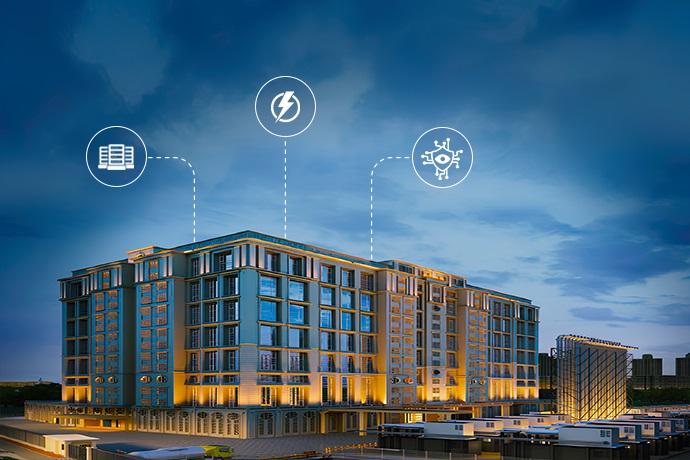As enterprises undergo rapid digital transformation, data centers have emerged as critical enablers of always-on, high-performance IT infrastructure. From hosting mission-critical applications to powering AI workloads, data centers offer organisations the scale, reliability, and security needed to compete in a digital-first economy. However, as more businesses migrate to colocation and hybrid cloud environments, understanding the intricacies of data center pricing becomes vital.
At the core of every data center pricing model are four key pillars: Power, Space, Network, and Support. Together, these elements determine the total cost of ownership (TCO) and influence operational efficiency, scalability, and return on investment.
1. Power: Power is the single largest cost component in a data center pricing model, accounting for up to 50-60% of the overall operational expense. Power is typically billed based on either actual consumption (measured in kilowatts or kilowatt-hours) or committed capacity – whichever pricing model is chosen, understanding usage patterns is essential.
High-density workloads such as AI model training, financial simulations, and media rendering demand substantial compute power, and by extension, more electricity. This makes the power efficiency of a data center critical measured by metrics like Power Usage Effectiveness (PUE). A lower PUE indicates that a greater proportion of power is used by IT equipment rather than cooling or facility overheads, translating to better cost efficiency.
When evaluating power pricing, businesses should ask:
– Is pricing based on metered usage or a flat rate per kW?
– What is the data center’s PUE?
– Can the data center support high-density rack configurations?
– Is green energy available or part of the offering?
2. Space: Data centers are increasingly supporting high-density configurations, allowing enterprises to pack more compute per square foot – a shift driven by AI workloads, big data analytics, and edge computing. Instead of traditional low-density deployments that require expansive floor space, high-density racks (often exceeding 10–15 kW per rack) are becoming the norm, delivering greater value and performance from a smaller footprint.
Advanced cooling options such as hot/cold aisle containment, in-rack or rear-door cooling, and even liquid cooling are often available to support these dense configurations, minimising thermal hotspots and improving energy efficiency.
Key considerations when evaluating space pricing include:
– What is the maximum power per rack the facility can support?
– Are advanced cooling solutions like in-rack or liquid cooling supported for AI or HPC workloads?
– Are there flexible options for shared vs. dedicated space (cage, suite, or row)?
– Is modular expansion possible as compute demand grows?
– Does the provider offer infrastructure design consulting to optimize space-to-performance ratios?
3. Network: While power and space house the infrastructure, the network enables it to function connecting systems, users, and clouds seamlessly. Power and space host your infrastructure, but it’s the network that activates it – enabling data to flow seamlessly across clouds, users, and geographies. Network performance can make or break mission-critical services, especially for latency-sensitive applications like AI inferencing, financial trading, and real-time collaboration.
Leading hyperscale data centers operate as network hubs, offering carrier-neutral access to a wide range of Tier-1 ISPs, cloud service providers (CSPs), and internet exchanges (IXs). This diversity ensures better uptime, lower latency, and competitive pricing.
Modern facilities also offer direct cloud interconnects that bypass the public internet to ensure lower jitter and enhanced security. Meanwhile, software-defined interconnection (SDI) services and on-demand bandwidth provisioning have introduced flexibility never before possible.
The network pricing model varies by provider, but key factors to evaluate include:
– Are multiple ISPs or telecom carriers available on-site for redundancy and price competition?
– What is the pricing model for IP transit flat-rate, burstable, or 95th percentile billing?
– Are cross-connects priced per cable or port, and are virtual cross-connects supported?
– Is there access to internet exchanges or cloud on-ramp ecosystems?
– Does the data center support scalable bandwidth and network segmentation (VLANs, VXLANs)?
4. Support: The fourth pillar Support encompasses the human and operational services that keep infrastructure running smoothly. From basic tasks like reboots and cable management to advanced services such as patching, compliance assistance, and disaster recovery, support offerings can vary significantly between providers.
Beyond tangible infrastructure, support services form the fourth critical pillar of data center pricing. These include remote hands, monitoring, troubleshooting, infrastructure management, and compliance support – all of which have a direct impact on uptime and business continuity.
While some providers bundle basic support into the overall pricing, others follow a pay-as-you-go or tiered model. The range of services can vary from basic reboots and cable replacements to advanced offerings like patch management, backup, and disaster recovery services.
Important support considerations include:
– What SLA’s are in place for incident resolution and response times?
– Is 24/7 support available on-site and remotely?
– What level of expertise do support engineers possess (e.g., certifications)?
– Are managed services or white-glove services available?
For enterprises without a local IT presence near the data center, high-quality support services can serve as a valuable extension of their internal teams.
Bringing It All Together
Evaluating data center pricing through the lens of Power, Space, Network, and Support helps businesses align their infrastructure investments with operational needs and long-term goals. While each of these pillars have individual cost implications, they are deeply interdependent. For instance, a facility offering lower space cost but limited power capacity might not support high-performance computing. Similarly, a power-efficient site without robust network options could bottleneck AI or cloud workloads.
As enterprise IT evolves driven by trends like AI, edge computing, hybrid cloud, and data sovereignty so too will pricing models. Providers that offer transparent, flexible, and scalable pricing across these four pillars will be best positioned to meet the demands of tomorrow’s digital enterprises.
As enterprise IT & data center needs evolve – driven by trends like AI, hybrid cloud, edge computing, and data sovereignty – so will pricing models. Providers that offer transparent, scalable, and flexible offerings across these four pillars will be best positioned to meet the demands of future digital enterprises.
Conclusion: For CIOs, CTOs, and IT leaders, decoding data center pricing goes beyond cost it’s about creating long-term value and strategic alignment. The ideal partner delivers a well-balanced approach across Power, Space, Network, and Support, combining performance, scalability, security, sustainability, and efficiency. Focusing solely on price, can result in infrastructure bottlenecks, hidden risks, and lost opportunities for innovation. A holistic, future-ready evaluation framework empowers organizations to build infrastructure that supports innovation, resilience, and growth.






















